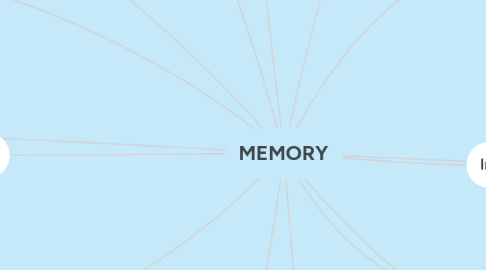
1. State-dependant learning
1.1. the tendency to recall information learned in particular physiological state most accurately when one is again in that state
2. Inability to Retrieve: Forgetting
2.1. Common reasons for forgetting: decay or interference (yellow bubble)
2.2. Special reasons for forgetting: false memories or motivated forgetting (repression) (yellow bubble)
2.3. Medical reasons: amnesia (memory loss) (yellow bubble)
3. Decay
3.1. The loss of information from memory as a result of disuse and the passage of time
3.2. Our mind reconstructs memories as best as we can
4. False memory
4.1. Occasionally we repress memories that are traumatic
4.2. Other times we create memories that did not occur
5. Amnesia
5.1. The inability to remember information
5.2. Two main types:
5.2.1. Retrograde: loss of memory for events and experiences that occurred in a period of preceding the amnesia causing even
5.2.2. Anterograde: loss of memory for events occurring after event
6. Memory Span
6.1. the limited number of items a person can reproduce from memory
6.2. Information is either quickly forgotten or processed further in long-term memory
7. Long-Term Memory
7.1. The storage mechanism that keeps a relatively permanent record
7.2. Two types;
7.2.1. Procedural Memory: unconscious once learned - memory for skills, including the perceptual, motor and cognitive skills required to complete complex task
7.2.2. Declarative Memory: memory for specific information (non-declarative memory: perform skills without recalling)
7.2.2.1. Episodic Memory: memory of specific personal events and situations (episodes), tagged with information about time Semantic Memory: memory of ideas, rules, words, and general concepts about the world
8. Ways to enhance memory
8.1. Chunking: grouping items to remember them in chunks
8.2. Acrostics and acronyms
8.3. Graphic organizers
9. Storage
9.1. The process of maintaining or keeping information available
9.2. Rehearsal: the process of verbalizing, thinking about, or otherwise acting on or transforming information in order to keep it active in memory (two types)
9.2.1. Maintenance Rehearsal: repetition of information with little or no interpretation
9.2.2. Elaborative Rehearsal: involves repetition and analysis, in which the stimulus may be associated with (linked to) other information and further processed
10. Retrieval
10.1. the process by which store information is recovered from memory
10.2. Retention of information can be retrieve in several ways:
10.2.1. Recall: ability to remember information when asked
10.2.2. Recognition: ability to notice information when presented with options
10.2.3. Relearning: a measure of how long it takes to learn something you previously learned
11. Interference
11.1. the suppression of one bit of information by another received either earlier or later or the confusion of two pieces of information
12. Sensory Memory
12.1. The ability to retain sensory information after the original stimuli have ended
12.2. Sensory receptors;
12.2.1. sight, sound, smell, taste, and touch

